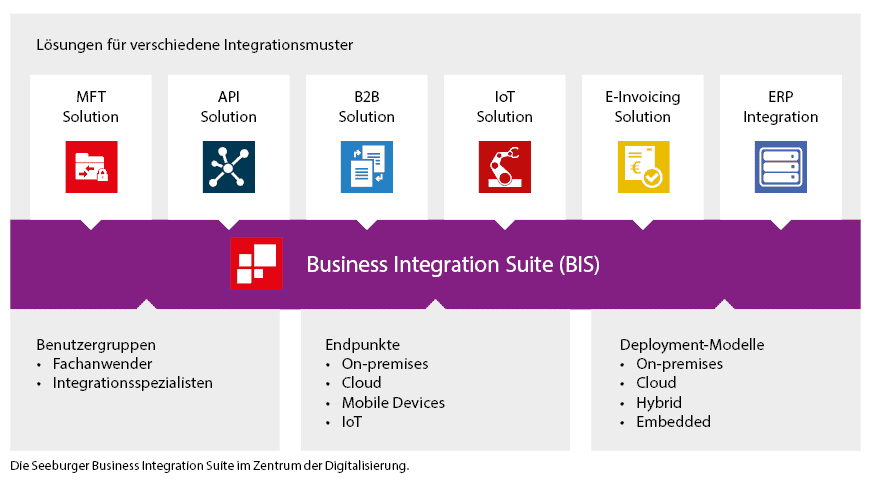Business Integration Suite—Ahead of its Time
![[shutterstock.com: 1234673626, Dmitriy Rybin]](https://e3mag.com/wp-content/uploads/2020/03/shutterstock-1234673626.jpg)

Roughly five years ago, Gartner developed the hybrid integration platform (HIP) approach. What started as a simple idea now dominates the integration scene – and Seeburger’s Business Integration Suite (BIS) also follows this idea.
As a sort of a reference model, Gartner’s approach offers providers as well as customers some guidance in the nearly unmanageable confusion around integration requirements. The renowned research and advisory company expects that in two years’ time, 65 percent of enterprises will have established some kind of hybrid integration platform (HIP).
Integration is closely connected with digitalization and digital transformation projects concerning the optimization of business processes for more speed, or concerning the implementation of completely new business models. One could even say that without comprehensive technological and organizational integration of systems, data and processes, and connected digitalization is impossible to achieve.
Framework and platform
But what does hybrid mean in the context of a hybrid integration platform? In general, it is about covering a broad spectrum of integration requirements that could be completely different from one another. This includes cloud and API integration in real-time, business-to-business integration (B2B/EDI), IoT or Industry 4.0 integration, international e-invoicing, ERP and enterprise application integration, and secure managed file transfer (MFT).
These integration patterns are also used for SCM topics like product data management, e-procurement, integration of production systems, e-commerce, inventory and logistics processes as well as more universal topics like HCM and CRM. Even in finance and banking, companies leverage—among more traditional integration technologies—lifecycle API management to optimize digital customer services.
Gartner uses both framework and integration platform to describe HIP. In brief, the difference between framework and integration platform can be defined as follows: Framework means absolutely everything in connection with integration. A hybrid integration platform, however, is kind of a middleware system, a universal solution providing functionality for the integration of processes, technologies and business applications.

Gartner demands that a hybrid integration platform has four main building blocks: aside from the aforementioned integration patterns, they are user groups, endpoints and deployment models.
User groups for example means professional users or integration specialists – the people in a company operating or working with a hybrid integration platform. Endpoints means on-premises or cloud systems, mobile devices or IoT technologies.
And, of course, the deployment model of the integration platform (or part of it) can be on-premises, in the cloud, hybrid or embedded (in the device or system).
Seeburger Business Integration Suite (BIS) as middleware
Seeburger provides an integration platform (middleware) that follows Gartner’s approach. For both mid-sized and enterprise companies, Seeburger offers individually tailored solutions (functionality wise). Gartner’s approach to the term hybrid integration platform (HIP), is applicable to many different functionalities and definitions. It adapts seamlessly to a company’s individual integration requirements.
Mid-sized companies especially need preconfigured solution building blocks for integration to quickly and efficiently satisfy their demand. Seeburger offers these building blocks with its Business Integration Suite (BIS) platform. Enterprise companies also often need an integration platform for organizational or governance purposes. If necessary, a hybrid integration platform can be developed based on multiple products.
With Business Integration Suite as a hybrid integration platform, Seeburger offers customers a complete package based on a one-platform strategy that covers all essential integration requirements from a business and technology perspective in a single system. Please note: Seeburger’s Business Integration Suite was developed long before the HIP approach.
One Platform Strategy
Companies benefit from a single platform approach—rather than patchwork solutions—for multiple reasons. For example, they can achieve synergies because staff have to learn and perfect handling and management of only one system. Furthermore, the modular structure of the platform offers the possibility to scale and expand on demand, whether it becomes necessary because of economic growth or technological reasons. It is also easier to protect the investment of one platform.
The platform also supports flexible operating models, such as on-premises or cloud deployments as well as hybrid operating models. SAP customers will find they are already familiar with Seeburger’s modular structure, as they have been selecting which SAP Business Suite or S/4 Hana modules they require for years. Just as customers can use one complete SAP solution, they can leverage Seeburger’s Business Integration Platform. And just as they can choose to only use the finance or logistics modules from SAP, they can choose to only use one BIS module from many.
One customer might only want to use BIS for B2B/EDI integration; another might start out with Seeburger’s API/EAI integration and then choose to also leverage SAP ERP, e-invoicing or IoT integration as well as managed file transfer. For countless use cases, BIS offers predefined templates, preconfigured mappings or API libraries, e.g. for SAP or B2B/EDI integration, and integrating web services via REST APIs. This for example reduces the time it takes to integrate different business partners via EDI down to just a few hours.

Governance and Operations
In enterprise companies, governance (controlling/monitoring) and operations play an important role when it comes to integration platforms. BIS has been comprehensively covering these special requirements for decades – which is one of the reasons that over 10,000 companies of all sizes worldwide have chosen BIS.
Seeburger serves mid-sized companies with few integration requirements as well as global enterprises with highly complex operational requirements. Seeburger has successfully positioned itself as single-source integration provider. Business Integration Suite is its flagship product. The company also offers comprehensive integration consulting services, and is available to answer integration and technology questions customers have, like:
How can I accelerate digitalization, business optimization and flexibility? What do I have to consider for integration projects? How can I establish sustainable API management and leverage it effectively? How can I tackle integration between SAP and non-SAP systems like Salesforce? How can I tackle SAP and SAP integration? What do I have to consider from a technological or organizational perspective when it comes to implementing an integration platform?
Focus on specific industries
Seeburger BIS also focuses on specific industries. Industry-specific versions of Business Integration Suite have predefined functionality and business content available. Industries include the automotive sector, CPG and retail, and energy and utilities.
The most recent BIS version is Major Release 6.7 and can be used as a hybrid integration platform for all integration scenarios. Furthermore, customers can leverage the solution to implement new business cases, in connection with artificial intelligence (AI), big data, blockchain, real-time API integration and IoT use cases.
PDF in English






